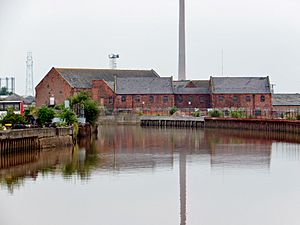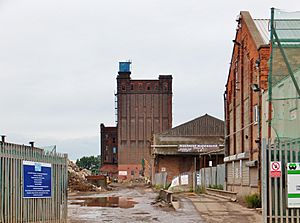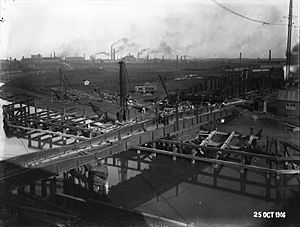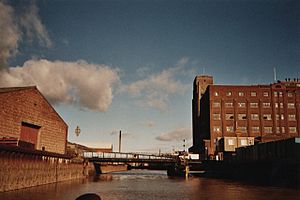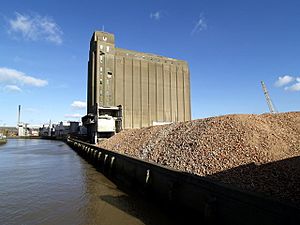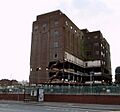Wilmington, Kingston upon Hull facts for kids
Wilmington is an industrial area in Kingston upon Hull, England. It sits on the east side of the River Hull. This area is known for its many factories and businesses.
Contents
- What is Wilmington Like?
- Wilmington's Past: A Look Back
- How Did Industry Start in the 1800s?
- What About Railways and Factories in the Late 1800s?
- How Did Wilmington Grow in the Late 1800s?
- What Happened in the 1900s?
- How Did Railways Change in the Early 1900s?
- What About New Factories in the Early 1900s?
- How Did World War II Affect Wilmington?
- What Changed in the Late 1900s?
- What is Happening in Wilmington Today (2000s)?
- Images for kids
What is Wilmington Like?
Wilmington is located in Hull, England. To its west is the River Hull, with areas like Wincolmlee and Sculcoates on the other side. Stoneferry is to the north, and The Groves is to the south. To the east, you'll find Summergangs and the Garden Village.
This area is mostly industrial, meaning it has many factories and businesses. These include places for recycling, making building materials, and other manufacturing. You'll also find shops and services that help these industries, like building suppliers. Big businesses here include Robin Concrete Waste Disposal and the Stagecoach Hull bus depot.
How Do People Get Around Wilmington?
Major roads like the A1033 (Stoneferry Road / Mount Pleasant) and A1165 (Cleveland Street) run through Wilmington. They connect the south of the area to Stoneferry in the north. The Hull Docks elevated railway also goes through Wilmington.
There are a few ways to cross the River Hull from Wilmington. The Hull Bridge is a swing railway bridge for trains. The Sculcoates Bridge on Chapman Street is a road bridge. There's also the Wilmington Swing Bridge, which used to be a railway bridge but is now a path for walking and cycling.
Are There Homes in Wilmington?
There are not many homes in Wilmington. Most of the area is for businesses and factories. However, there is a permanent caravan site called Wilmington Park where people live. Because of the many industries, the area sometimes has issues with smells or dust from traffic, factories, and waste sites.
Wilmington's Past: A Look Back
Wilmington has a rich history, especially with its industries and railways.
How Did Industry Start in the 1800s?
In 1846, the Hull Glass Company started in Wilmington. It was on the north side of what is now Glass House Row. However, this company didn't last long and closed by 1850.
The Victoria Dock Branch Line railway opened in 1853. This railway went through Wilmington from east to west. It crossed the River Hull using a new swing bridge called Wilmington Bridge.
By the mid-1850s, Wilmington had a few buildings, including the old glass works, a cement factory, and a brick field. Along the river, there were also industrial buildings like the Phoenix Mill (for oil) and the Wilmington (oil and glue) and Greenland yards. Much of the area was still empty land back then.
What About Railways and Factories in the Late 1800s?
The Hull and Hornsea Railway opened in 1864. It first ended at Wilmington station. In the same year, the Victoria Dock Branch Line was made into a double track. Over time, the railway sidings (extra tracks for parking trains) grew into a large goods station called Wilmington goods.
In 1866, Earle's Cement took over the cement factory near the river. This factory was connected to the railway. It made a type of cement called Roman cement. Later, they started making Portland cement using special kilns (large ovens). By 1906, they had installed modern rotary kilns, which greatly increased how much cement they could make.
In 1875, a new road bridge, Sculcoates Bridge, opened over the River Hull at the southern edge of Wilmington. This was also a swing bridge, allowing boats to pass.
In 1885, the Hull and Barnsley Railway opened. It had a branch line that went through the northern part of Wilmington to the new Alexandra Dock. This line crossed Cleveland Street on a high embankment.
How Did Wilmington Grow in the Late 1800s?
By the late 1880s, the town of Hull was growing northwards into Wilmington. A school, Chapman Street school, opened in 1888 for many children. It was later made even bigger. In 1898, a temporary iron church was built, which was replaced by a brick church, St Saviour, in 1903.
What Happened in the 1900s?
The large Swan Flour Mill was built in 1897 and expanded in 1898, with a silo added in 1906. Other businesses also started around this time, including varnish works, oil refineries, and other flour mills.
In the early 1900s, a factory making metal tins (canisters) was set up. Reckitt and Sons bought this factory in 1907.
By 1910, more homes were built, mostly terraced houses, around streets like Withernsea, Dalton, Cornwall, and Chapman streets.
How Did Railways Change in the Early 1900s?
Between 1910 and 1912, the railway lines in Wilmington were changed. A new Wilmington station was built. The railway crossing at Cleveland Street was replaced with a bridge, so trains could go over the road. Around 1905, a new double-track swing bridge was built over the River Hull, slightly north of the old single-track bridge. This new bridge was very modern for its time, using electricity to turn.
A cinema called the Cleveland opened on Cleveland Street in 1914, giving people a place to watch movies.
What About New Factories in the Early 1900s?
In 1915, the British Extracting Co. started an oil processing plant. A large silo and a facility for bringing goods by river were completed in 1919. This plant focused on making cooking fat and margarine. An extension factory for making New Pin Soap opened in 1921. However, this factory closed by 1934 after a big company bought its parent company.
In 1940, Gill & Duffus opened a cocoa mill, British Cocoa Mills (Hull) Ltd., on Cleveland Street.
How Did World War II Affect Wilmington?
During World War II, the River Hull area was a major target for bombing raids. The Spillers Mill was almost completely destroyed by bombs. Chapman Street school and the Cleveland cinema were also damaged. Spillers Mill was rebuilt in the late 1940s and early 1950s, including a very tall concrete silo.
In 1948, there was an explosion and fire at the Hull cocoa factory. A tank of petrol used in making cocoa broke and caught fire. A new mill was rebuilt by 1952.
What Changed in the Late 1900s?
Wilmington station closed in 1964, and the Victoria Dock Branch Line railway closed in 1968. The Wilmington cement works closed in 1969. The Cleveland cinema was torn down in 1960.
In the 1970s, most of the old Victorian houses were removed. By the 1980s, Wilmington became mostly industrial or empty land. A caravan site opened in Wilmington in 1976. St Saviours church was also torn down in 1981.
In the 1990s, an industrial estate called Stoneferry Park was built. It used some old buildings and added many new ones for businesses. Around the same time, a new bus depot for Hull's buses was built. It opened in 1996.
What is Happening in Wilmington Today (2000s)?
In the early 2000s, there were plans for a large waste handling facility, including an incinerator, at Foster Street. This plan caused a lot of discussion and opposition from local people. The council and later an appeal refused the plans.
The Spillers' Swan Mill was torn down around 2007. In 2010, the ADM Cocoa mill closed.
In 2011, a company called Spencer Group proposed a new plant to turn waste into energy. This plant would use waste wood and other industrial waste to create electricity and gas. The plan was approved and received a large grant.
By 2014, construction began on the first part of this big project. In 2015, funding was secured, and construction was set to start in early 2016. The facility is expected to be working by early 2018.
Images for kids


